How To Kill Fleas in Your Yard — A Complete Guide
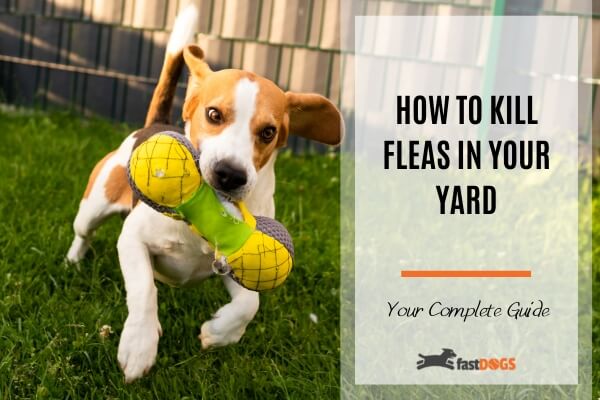
How To Kill Fleas in Your Yard — A Step-by-Step Guide
Fleas can be a common problem for dog owners, but if you have a flea infestation in your outside space, it can be a nightmare for both you and your pooch. In this guide, we will show you how to kill fleas in your yard using various products and techniques, as well as how to prevent them from coming back.
But how do you kill fleas in your garden without resorting to chemicals that can also be hazardous to your pup’s health? Let’s find out.
Why Flea Control Is So Important?
For several reasons.
Where dogs are concerned, fleas can cause:
Itching.
Tapeworm.
Heartworm.
Anemia — puppies are particularly at risk due to less blood volume and an underdeveloped immune system.
They can also transmit many diseases, and in more severe cases result in a serious loss of blood and potentially fatal illnesses.
Fleas spread germs by feeding on their host, or through fecal contamination. That is, when an infected flea’s feces (aka flea dirt) is scratched into an open wound. And, although these tiny bugs generally prefer an animal host — there are more places to hide in their fur — they bite humans too, often causing an allergic reaction in the form of hives.
The thing is, fleas are minute wingless insects — we’re talking 0.125 inches in length and dark brown or black — so they’re tough to spot.
And, laying over 50 eggs a day, adult fleas can often live up to several months — when favorable conditions exist — or if there is no effective flea treatment for yard in use. That’s a lot of potential fleas looking for a host, such as your pup to feed on!
Hence, why you need to stamp them out — it doesn’t take long for fleas to become a big headache in your yard.
What Kills Fleas?
What kills fleas in a yard instantly, in most cases, is pesticides or contact sprays. However, you must choose a pesticide or insecticide that’s non-toxic to your pooch or any children who may play in the yard.
Although pet-friendly plant-based pesticides do exist, many dog owners look for more natural and environmentally friendly methods of killing fleas. This can involve organic products like nematodes (small worms) or diatomaceous earth, which we’ll look at later — or homemade flea killers.
Flea-Specific Sprays
Specialized flea sprays for garden treatment will kill all existing fleas and their laid eggs while deterring new fleas from infesting the yard.
There are several insecticides available specifically designed to get rid of fleas in yards that contain pyrethrins — a natural flea killer. Sourced from the chrysanthemum plant’s flowers, pyrethrins are effective at exterminating fleas, but also safer for use in households with pets.
How To Use Flea Treatment for Yard
Simply follow the manufacturer's instructions for application rate, frequency, and safety precautions for use around animals or children.
Insect Growth Regulators (IGRs)
Insect Growth Regulators (IGRs) don’t kill fleas on impact but can be an effective tool for preventing a flea infestation. And, when mixed with a pesticide it will both kill adult fleas and inhibit the growth cycle of flea eggs and larvae.
Best of all, the chemicals in IGRs are virtually non-toxic to both humans and dogs. However, on contact, they can cause skin or eye irritation — so keep pets indoors while you’re spraying.
IGRs can be bought as a ready-to-use spray, a concentrate you mix with water, or in a mixture with a pesticide that kills adult fleas.
How To Get Rid of Fleas in Yard With IGRs
You can use a spreader to apply granular products, or a hose-end sprayer to apply liquid products.
Granular Product
Measure your yard/treatment area, and follow the manufacturer's instructions for dosage — as in, how many ounces or pounds to spread per square foot.
Fill the hopper of your spreader with the suggested quantity.
Apply the granules over your treatment area. For a more uniform coverage, make a two-pass-through — in a grid-like fashion.
Once you have evenly spread the granules, you’ll need to water-in the granules to activate them and ensure the pesticide or IGR works its way into the soil.
Liquid Product
Fill up the chamber of your hose attachment with the required amount of IGR according to the instructions.
Once filled, attach the sprayer to the end of your regular garden hose.
Switch on the water, and aim the sprayer at the area you want to treat.
As you spray, the IGR and water will mix together. Avoid over-spraying one area too much by constantly moving the sprayer as you apply the product.
Home-Made Flea Spray for Your Yard
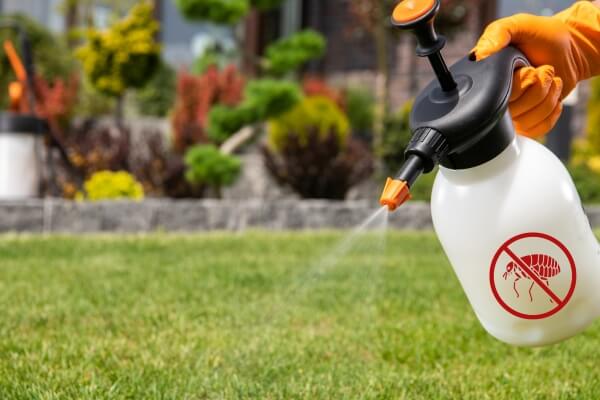
If you prefer to make your own homemade flea spray with only natural ingredients, there are many household liquids you can use. Many essential oils will kill a flea by damaging their exoskeletons, but some are also toxic to your pup, like tea tree, so check that it’s dog-friendly first.
How To Kill Fleas in Your Yard With a Home-Made Spray
First, you will need to make your spray. So, mix up the following:
One part apple cider vinegar.
One part dish soap.
Two parts water.
A few drops of essential oil — such as peppermint or clove oil.
Now, apply the flea spray as you would any commercial pesticide.
Flea Collars
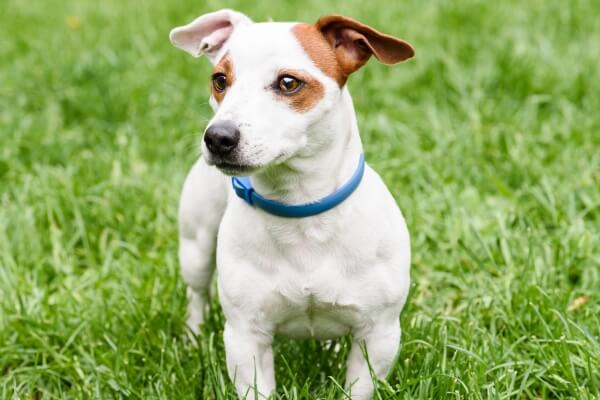
Flea collars, which you often put around your dog’s neck, don’t harm your pup but do kill and/or prevent fleas — depending on which brand you buy. You could also use those same flea collars in your yard to kill and prevent flea infestations.
How To Get Rid of Fleas With Flea Collars
Purchase enough dog flea collars for the size of your garden.
Place them in areas where you think fleas may be hiding, or breeding. To secure them, tie the collars around plant and shrub stems.
Home Remedies for Fleas in Yard Treatment
You can find many natural flea-killing remedies at either your local garden center or even in your store cupboard.
Soap and Water
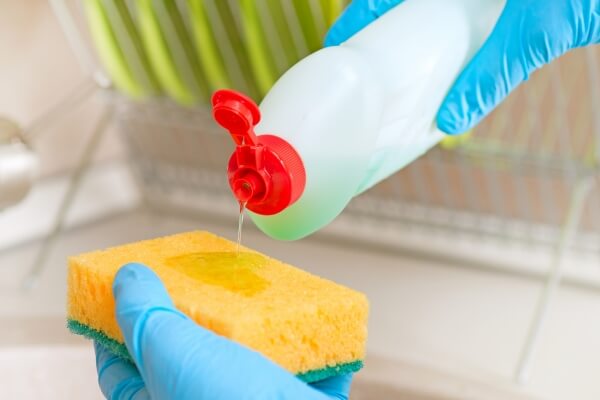
A simple pet-friendly pesticide you can make at home uses any regular dish soap and works by reducing the surface tension of the water. This causes fleas to sink and drown. Dish soap can also damage the exoskeleton of fleas, which results in the soapy water entering the flea’s respiratory tract and drowning them.
How To Eliminate Fleas Using Soap and Water
Fill a yard sprayer with water and add 1 ounce of liquid dish soap.
Spray your entire yard with the soap and water mixture — preferably late afternoon/evening — to avoid evaporation.
Check your yard in the morning for any signs of fleas. If they’re still present, repeat the process until they’re gone.
Note: Although dish soap and water may kill a flea if sprayed directly on them, it won’t kill the flea eggs. And, you’ll have to frequently apply it to your yard until the infestation is under control.
Cedarwood Chips/Oil
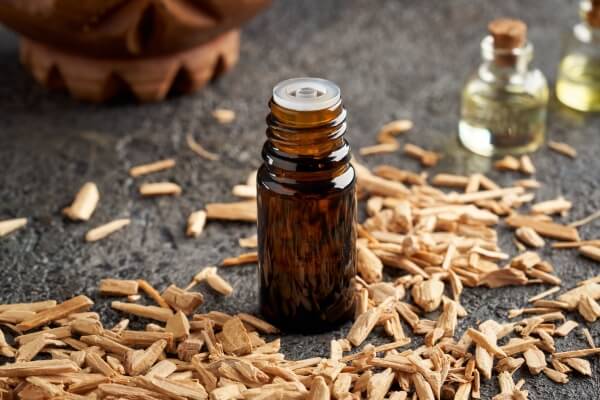
Cedar is a natural flea repellent you can spread around your garden and the perimeter to deter any fleas from trespassing into your yard. These chips are completely safe for your pooch and are often used in pet bedding.
Placed on top of the soil along your fence boundaries, cedar can prevent any future invasion of fleas from neighboring properties. You could also spray your yard with cedarwood essential oil, which is safe for the environment, humans, and pets.
Beneficial Nematodes
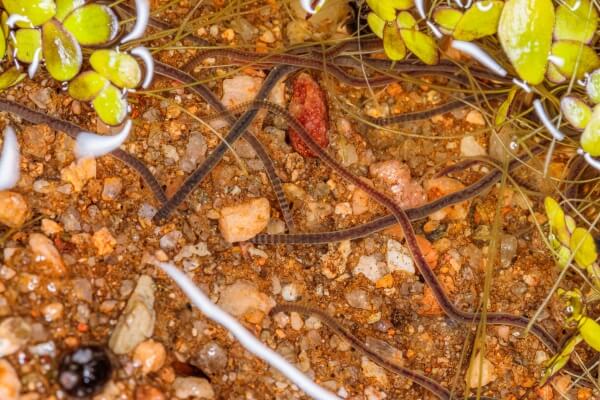
If you’re looking for a completely natural and organic way how to eliminate fleas, try picking up some nematodes from your local garden center or online.
Nematodes are tiny, microscopic roundworms that can live in the soil around plants. They basically feed on fleas and flea eggs that may be in your yard. Best of all, they’re completely harmless to humans, your lawn, and, of course, your lovable pup — they only have eyes for fleas.
Nematodes tend to come in packages that contain a staggering 10 million of them and cover areas between 2000 and 3000 square feet.
How To Eliminate Fleas With Nematodes
Typically arriving in a powdery solution, you’ll need to mix it with water first.
Either transfer into a watering can or use your hose spray attachment.
Apply to your lawn and any other areas that require treatment,
Nematodes will go to work straight away, and within 24 hours, you should see a reduction in the flea population.
Diatomaceous Earth (DE)

Diatomaceous earth is a natural powder made from fossilized diatoms and is one of the world’s most effective insecticides. DE is non-toxic to humans and pets as long as it’s food-grade. Filter grade (also known as swimming pool DE) can cause serious damage to the lungs and eyes, so double-check the label before using.
How To Kill Fleas in Yard With Diatomaceous Earth
Simply cover your lawn (or the flea-prone areas) with a thin layer of DE.
This powder can eliminate fleas very rapidly and also prevents fleas from building up a resistance to it. DE disrupts that hard lipid barrier around the flea, which keeps the water in, and the flea dies by drying out.
Note: DE only works in a dry environment. Hence, if you live somewhere with more humidity, it may not be effective. If you use sprinklers in your yard or it rains a lot, you will need to reapply very frequently.
Water

Perhaps the simplest way to get rid of fleas, but not the tidiest, is to flood your lawn or yard. Waterlogged grass is inhospitable to flea eggs and larvae, and flooding your garden is an aggressive way to break the life cycle of fleas.
As well as destroying any flea eggs or larvae, the water can also wash away any of the adult flea feces which young fleas feed from.
How To Get Rid of Fleas in Yard With Water
Grab your garden hose, and completely drench the area — in particular, areas around trees, patio furniture, and anywhere your pet often likes to sit.
To ensure any larvae and eggs are coated in water, you will need to make sure the entire grassy area of your yard is completely wet.
How To Get Rid of Fleas In Your Yard — Step by Step
So, now we know the importance of getting rid of the fleas in your yard and the safe treatments we can use. Let's take a look at the steps to successfully kill fleas in yards and keep it free from these tiny bugs.Step 1 — Mow Your Lawn

Maintaining your lawn by keeping the grass short, and removing any piles of recently cut grass can help cut down the number of fleas. Keeping your grass shorter will provide fewer hiding places for the fleas to breed in.
And, fleas aren’t sun worshippers — they don’t like direct sun-exposed areas — it can get too hot for them. So, getting rid of as much shade as you can will also prevent an invasion.
Step 2 - Identify the Flea Infested Areas
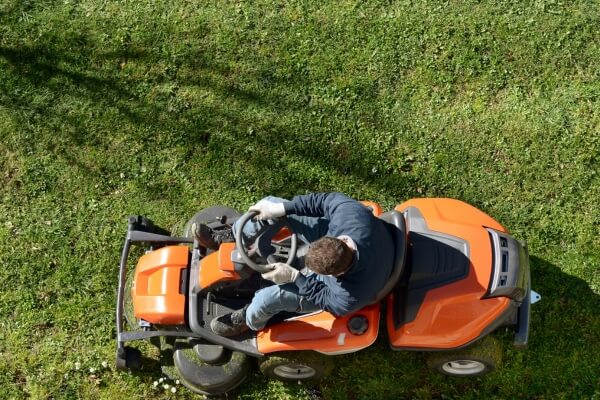
When attempting to get rid of fleas in your yard, it’s important to recognize the signs of a flea infestation. For example, if you see small black spots on your plants that look like dirt or sand, it might be flea dirt.
Fleas generally prefer dark, moist, and shady places where they will hide and lay eggs. They will often congregate in areas where your pup spends most of their time, such as under decks, porches, hedges, or trees.
Debris and loose leaves in your yard can make perfect environments for fleas that live in the soil areas where they find shelter and food.
The easiest way to check for fleas in your yard is to wear a pair of white socks and patrol around the suspected areas. If fleas are present, they will jump on your socks and be visible against the white background.
Step 3 – Treat Your Yard With a Pet-Friendly Flea Killer
Now, decide which treatment/s you wish to use:
Step 4 – Spray Around the Perimeter of Your Home

You don’t want to just get rid of fleas in the yard, you want to eliminate them from your home too. They often say only five percent of the fleas in your home are actually on your pooch, the rest hide in your furniture or carpets.
To prevent fleas from moving in, you need to create a barrier around your house that is unfriendly to them. (You can use the same pet-friendly flea treatment/s from Step 3).
Apply the product along the patio and foundation areas of your property, making sure to cover any gaps where fleas could sneak in.
Step 5 – Keeping Indoors Flea Free
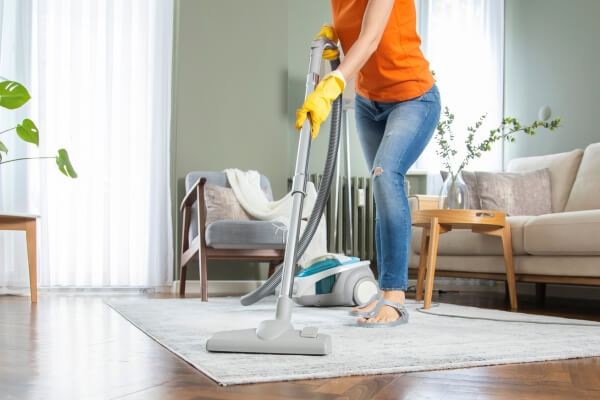
Treat your pooch with a medicated flea shampoo, topical cream, spot-on or chewable tablet at the same time as spraying your yard.
Inside the home, any soft furnishings that can be washed should be put in the laundry at the highest temperature possible to kill fleas or larvae.
If you don’t treat your home at the same time as the yard, you run the risk of the fleas returning.
Final Thoughts
If you have fleas in your yard, it’s in your and your dog's best interest to make sure you get rid of them as soon as possible.
The fastest and most permanent way of eliminating fleas is to use an attack-from-all-angles approach — treating the problem head-on, maintaining a yard that’s inhospitable to fleas, and creating natural barriers to prevent them from invading your outside space.
Hopefully, by following this guide on how to kill fleas in your yard you can effectively eliminate all flea infestations and prevent them from coming back. If you do have a severe or more persistent problem, you may need to contact a professional pest control service for assistance.
How To Eliminate Fleas in Your Yard FAQs
How Do You Kill Fleas Naturally?
Many natural ingredients, including cedar, lemon juice, and salt can be effective repellents for fleas and effective at killing them.
A homemade mixture of apple cider vinegar and neem oil is one of the best ways to get rid of fleas, which also repels ticks. As they’re both natural products, they won’t harm you, your pup, or the yard.
Will Vinegar Kill Fleas?
No, it’s an old wives’ tale that vinegar alone can be used to kill fleas in a yard. Although fleas may be repelled because they don’t like the odor or taste, vinegar is only a mild detergent and not the best flea remedy.
How Does Baking Soda Kill Fleas?
Baking soda will dehydrate a flea and kill it on contact. Better used in dry climates, you could sprinkle some baking soda in your home and leave it for a few hours before vacuuming it up along with any dead fleas. You could even add some baking soda to a pup’s dry shampoo to help eliminate any fleas that may be hiding in their coat.
How Do I Get Rid of Fleas in My Yard Fast?
The most effective flea control for yards contains ingredients such as permethrin or dinotefuran. These pesticides are lethal to adult fleas at the biting stage and will also include an insect growth regulator that stops the development of any eggs and larvae.
Although none of these ingredients are toxic to dogs when used correctly, ensure to store them away from your inquisitive pup — they can be harmful if consumed.
Can You Use Boric Acid To Get Rid of Fleas in Yards?
Boric acid will certainly kill the fleas in your yard, including any eggs and larvae. When formulated correctly, the product only contains 5 percent boric acid and isn’t expected to harm pets. Boric acid is considered low to moderately toxic to dogs even if very large amounts of the granules are digested. Fortunately, the granules should not be attractive to dogs or other non-target animals.
Does Rain Kill Fleas in Yard?
No, as a rule, rain will not kill fleas effectively. Although excessive rainfall can interrupt the life cycle of fleas and wash away any eggs or larvae, adult fleas are surprisingly resilient. They can even survive up to 48 hours submerged in water — as long as their hard, exterior lipid “shell” is intact.
Rain can be a mixed blessing when you have a flea infestation in your yard — as the water leaves a moist environment in which fleas thrive. Rain can also wash away many of the natural treatments such as cedar chips or homemade pesticides you have treated your yard with.
